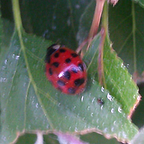So, a method used by virologists to change the characteristics of a virus is to infect an animal, then isolate the virus from animal 0 and use it to infect animal 1, take virus from animal 1 and use it to infect animal 2, this continues for many rounds. The initial virus used to infect animal 1 may look different to the virus used to infect animal 200. The differences can result in a weaker virus or a stronger virus, but either way it will have changed. This is known as serial passage of a virus.
Why does the virus change? Because every time in replicates, making more virus, it must duplicate its genetic material and with each replication it can make mistakes and some mistakes are kept. Why? Because these mistakes give the virus an advantage compared to the original virus. Now, not every mistake (mutation) will cause the virus to change significantly, sometimes it is just small changes here and there in the virus’s genetic code, but no noticeable changes in how the virus “acts”. But sometimes changes do give the virus an advantage; maybe it just grows better, is more fit, maybe it is more infectious, or maybe it escapes the immune response. The more the virus replicates the more potential mistakes and potential changes.
The COVID-19 pandemic is a real-life illustration of serial passage. The virus has been passed to millions of people; therefore, it has changed, it has evolved. Like any biological entity it has external pressures on it to survive, if necessary, it will change to survive. As the pandemic hit, we virologists knew that genetic changes in COVID-19 was a real possibility, but when and these changes would occur no one could predict and how they would affect the virus, again, no one can predict.
Variants are popping up in various states, with humans infected at such a high rate, variants were inevitable. At of the time of this writing, the National Center for Biotechnology Information (NCBI), has collected over 100,000 viral genetic sequences. This and other surveillance programs have led to the discovery of the various COVID-19 variants. Variants put us all at risk, we run the real risk that the current vaccines not being as effective against a new variants or previously infected patients will not be protected against these new variants, much like the common cold or influenza, except COVID-19 is much more dangerous.
To prevent even more COVID-19 variants from developing then we must stop the infection rates, yes, I know easier said than done, as evidenced by over 29.5 million people infected. The current vaccines will help, and more vaccines are in the pipeline, as well as other therapeutics, vaccine boosts may be necessary to protect against any new variants. But we as humans must be the major force behind stopping more variants from cropping up.
Even with some restrictions being lifted, we can still make it harder for the virus to spread and mutate, get vaccinated when it’s your turn, keep wearing a mask, keep social distancing, follow the new restrictions, stay home when possible, wash your hands. Keep safe and healthy.
